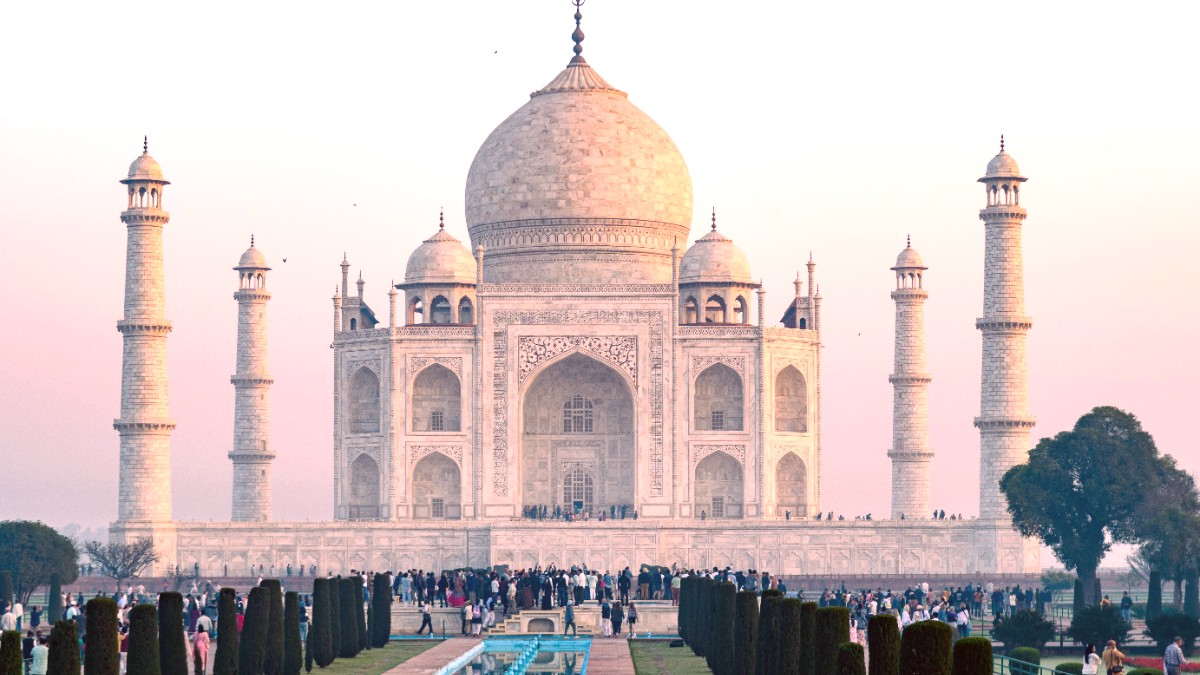
Uttar Pradesh, India
Historical and Cultural Context: The Taj Mahal is an UNESCO World Heritage Site and a global icon of love and architectural brilliance. Mughal Emperor Shah Jahan commissioned this white marble mausoleum in memory of his beloved wife, Mumtaz Mahal, who passed away in 1631. Construction began in 1632 and was largely completed by 1653. It represents the pinnacle of Mughal architecture, blending elements from Indian, Persian, and Islamic architectural styles. Its symmetry, delicate marble inlay work (pietra dura), and grand scale symbolize eternal devotion and artistic perfection.
Book tours and tickets via GetYourGuide.
This tomb, built for Mirza Ghiyas Beg, predates the Taj Mahal and is considered a precursor. It marks a transition to white marble in Mughal architecture, known for exquisite marble lattice work and intricate pietra dura ornamentation. Entry fee for foreigners is ₹310.
The mausoleum of Emperor Akbar, located about 13 km from Agra. It showcases unique architecture blending various religious and architectural motifs, reflecting Akbar's secular vision. The complex sits within a large garden populated by deer. Entry fee for foreigners is ₹310.
A Mughal garden complex situated directly across the Yamuna River from the Taj Mahal. Designed to offer a perfect setting for viewing the Taj Mahal, it presents spectacular, unobstructed views of the monument, especially at sunset. Entry fee for foreigners is ₹300.
While Agra is mainly celebrated for its architectural marvels, the region also features natural attractions, with one significant site for wildlife enthusiasts.
The Yamuna River forms the backdrop to the Taj Mahal, adding to its picturesque setting. While the river itself is unfortunately often polluted, it presents unique perspectives of the monument from its banks, especially from areas like Mehtab Bagh.
Unofficial boat rides (often small rowboats) are sometimes available on the Yamuna River near Mehtab Bagh. These rides offer a different vantage point for photographing the Taj Mahal from the water. Exercise caution and negotiate the price carefully if you choose to take one of these unregulated boat trips. It is a scenic activity rather than a significant natural attraction.
A UNESCO World Heritage Site, this is a major bird sanctuary and a wetland reserve. It sits in Bharatpur, Rajasthan, approximately 60 km (37 miles) west of Agra. The park presents a haven for thousands of resident and migratory birds, making it a paradise for birdwatchers and nature photographers. During the winter months, migratory birds from Central Asia and Europe flock to the sanctuary.
Excellent for birdwatching, especially during the winter season (October to March) when migratory species are present. You can explore the park on foot, by bicycle (rentals available at the entrance), or by cycle-rickshaw (hired locally with knowledgeable drivers who serve as guides). This makes an excellent day trip from Agra, providing a refreshing contrast to the city's historical sites.
Beyond the well-trodden path, Agra holds several lesser-known sites that feature unique architectural details, historical significance, or a quieter experience away from the crowds.
This Persian-style tomb stands out for its extensive and unique use of glazed tiles ('chini' work) in its ornamentation. It offers a glimpse into a different decorative style of the era. It is a relatively quiet and less visited site, allowing for peaceful exploration.
The tomb of Emperor Akbar's Rajput wife and Emperor Jahangir's mother. It blends Hindu and Islamic elements, reflecting cultural synthesis. A visit here presents a quieter, more personal connection to Mughal history.
These sites provide distinct experiences beyond the major tourist hubs.
Make the most of your sightseeing in Agra with these practical tips.
A few considerations for a comfortable visit.
Enhance your historical understanding with local expertise.
Information for visitors with mobility considerations.
Tips for capturing your memories respectfully.
Strategic planning makes your Agra sightseeing smooth and memorable.
Visit the Taj Mahal at sunrise for fewer crowds and best light. Follow with Agra Fort, then Itmad-ud-Daula's Tomb. A day trip to Fatehpur Sikri is a separate excursion.
Allow 2-3 hours for the Taj Mahal and 2-3 hours for Agra Fort. Fatehpur Sikri requires a half-day or full-day, including travel.
Auto-rickshaws and taxis are readily available for travel between sites. Electric carts service the Taj Mahal entrance. Pre-booking taxis for day trips like Fatehpur Sikri is advisable.
Check the Archaeological Survey of India (ASI) website for official ticket booking and the latest visitor information for monuments.
Visit ASI WebsitePlatforms like GetYourGuide offer a range of tours, including skip-the-line tickets, guided tours, and day trips from Agra.
Explore GetYourGuide AgraYour hotel concierge can assist with local transport, trusted guides, and tour bookings.
Refer to Accommodation GuideThe high season (October to March) brings pleasant weather, ideal for sightseeing. Summers (April-June) are very hot, and monsoons (July-September) bring rain.
Respect local customs and dress codes at religious and historical sites.
Tips for moving around Agra efficiently and safely.
While touts are common, most local vendors and service providers are genuine and hospitable.
A firm but polite "no thank you" is generally sufficient to deter unwanted attention.
Agra's charm extends to various other experiences beyond the well-known monuments.
Immerse yourself in the bustling atmosphere and find unique souvenirs.
Find tranquility amidst historical settings.
Experience the history through captivating shows.
Booking tickets in advance for the show is recommended, especially during peak season. Find tickets on GetYourGuide.
Witness traditional craftsmanship firsthand.
Be prepared for sales pitches as these visits often lead to opportunities to purchase items. Look for shops that demonstrate the genuine inlay process for authenticity.
Explore Agra's diverse religious landscape.
A global icon of love and architectural brilliance. Visit at sunrise for fewer crowds and optimal photography. Purchase tickets online.
Massive red sandstone fortress, a city within a city. Fatehpur Sikri is an ancient, well-preserved capital nearby, ideal for a day trip.
Explore hidden gems like Itmad-ud-Daula's Tomb (Baby Taj), Akbar's Tomb, and local markets for a historical and cultural dive.